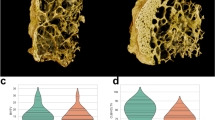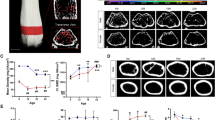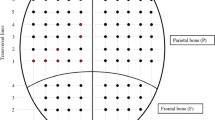Abstract
Hyperostosis frontalis interna (HFI) represents irregular thickening of the endocranial surface of the frontal bone, mostly seen in postmenopausal females. The microarchitecture of this condition is poorly studied. The aim of this cross-sectional autopsy study was to investigate and compare microarchitectural structure of the frontal bone affected with HFI in both sexes and to test whether HFI severity could be distinguished at the microarchitectural level. The sample was taken from human donor cadavers, 19 males (61 ± 15 years old) and 17 females (75 ± 15 years old). After classification of HFI severity (type A, B, C or D), samples of the frontal bone were taken and scanned using micro-computed tomography. Bone volume fraction was higher and total porosity lower only in the outer table of males with HFI, compared to females with HFI. Mean total sample thickness differed only between males with HFI type A and D. Bone microarchitecture between males and females with corresponding HFI types (e.g., male with type A versus female with type A) differed only in HFI type C regarding the fractal dimension of diploe. The degree of anisotropy differed between HFI subtypes in males, but the post hoc analysis revealed no significant differences between individual groups. Other microarchitectural parameters did not differ among males with different HFI subtypes, as well in females, in any part of the frontal bone. There is no difference in microarchitectural structure of the frontal bone between males and females with HFI, in general aspect and within corresponding HFI subtypes. HFI severity could not be distinguished at the microarchitectural level, neither in males nor in females.

Similar content being viewed by others
Data Availability
Data are available upon request.
References
Brickley M, Mays S (2019) Hyperostosis frontalis interna. In: Buikstra J (ed) Ortner’s identification of pathological conditions in human skeletal remains, 3rd edn. Academic Press, San Diego, pp 531–566
Hershkovitz I, Greenwald C, Rothschild BM et al (1999) Hyperostosis frontalis interna: an anthropological perspective. Am J Phys Anthropol 109:303–325. https://doi.org/10.1002/(SICI)1096-8644(199907)109:3<303:AID-AJPA3>3.0.CO;2-I
Ruhli FJ, Kuhn G, Evison R et al (2007) Diagnostic value of micro-CT in comparison with histology in the qualitative assessment of historical human skull bone pathologies. Am J Phys Anthropol 133:1099–1111. https://doi.org/10.1002/ajpa.20611
Bracanovic D, Djonic D, Nikolic S et al (2016) 3D-Microarchitectural patterns of Hyperostosis frontalis interna: a micro-computed tomography study in aged women. J Anat 229:673–680. https://doi.org/10.1111/joa.12506
Saukko P, Knight B (2004) Knight’s forensic pathology. Arnold, London
Sheaff M, Hopster D (2005) Post mortem technique handbook, 2nd edn. Springer, London
Salmi A, Vuotilainen A, Holsti LRUC (1962) Hyperostosis cranii in a normal population. Am J Roentgenol 87:1032–1040
Dann S (1951) Metabolic craniopathy: a review of the literature with report of a case with diabetes mellitus. Ann Intern Med 34:163–202
Moore (1944) Metabolic craniopathy. Am J Roentgenol 35:30–39
Fulton JD, Shand J, Ritchie D, McGhee J (1990) Hyperostosis frontalis interna, acromegaly and hyperprolactinaemia. Postgrad Med J 66:16–19
May H, Mali Y, Dar G et al (2012) Intracranial volume, cranial thickness, and hyperostosis frontalis interna in the elderly. Am J Hum Biol 24:812–819. https://doi.org/10.1002/ajhb.22325
Rühli FJ, Henneberg M (2002) Are hyperostosis frontalis interna and leptin linked? A hypothetical approach about hormonal influence on human microevolution. Med Hypotheses 58:378–381. https://doi.org/10.1054/mehy.2001.1481
Kollin E, Feher T (1986) Androgens, bone mineral content and hyperostosis frontalis interna in pre-menopausal women. Exp Clin Endocrinol 87:211–214. https://doi.org/10.1055/s-0029-1210546
Western AG, Bekvalac JJ (2017) Hyperostosis frontalis interna in female historic skeletal populations: age, sex hormones and the impact of industrialization. Am J Phys Anthropol 162:501–515. https://doi.org/10.1002/ajpa.23133
Glab H, Szostek K, Kaczanowski K (2006) Hyperostosis frontalis interna, a genetic disease?: Two medieval cases from Southern Poland. HOMO 57:19–27. https://doi.org/10.1016/j.jchb.2005.08.001
Gershon-Cohen J, Schraer HBN (1955) Hyperostosis frontalis interna among the aged. Am J Roentgenol 63:396–397
Schneeberg NG, Woolhandler GLR (1947) The clinical significance of hyperostosis frontalis interna. J Clin Endocrinol 7:624–635
Flohr S, Witzel C (2011) Hyperostosis frontalis interna—a marker of social status? Evidence from the Bronze-Age “high society” of Qatna, Syria. Homo 62:30–43. https://doi.org/10.1016/j.jchb.2010.12.001
May H, Peled N, Dar G et al (2010) Hyperostosis frontalis interna and androgen suppression. Anat Rec 293:1333–1336. https://doi.org/10.1002/ar.21175
Nikolić S, Djonić D, Živković V et al (2010) Rate of occurrence, gross appearance, and age relation of hyperostosis frontalis interna in females: a prospective autopsy study. Am J Forensic Med Pathol 31:205–207. https://doi.org/10.1097/PAF.0b013e3181d3dba4
Rühli FJ, Böni T, Henneberg M (2004) Hyperostosis frontalis interna: archaeological evidence of possible microevolution of human sex steroids? HOMO 55:91–99. https://doi.org/10.1016/j.jchb.2004.04.003
Belcastro MG, Todero A, Fornaciari G, Mariotti V (2011) Hyperostosis frontalis interna (HFI) and castration: the case of the famous singer Farinelli (1705–1782). J Anat 219:632–637. https://doi.org/10.1111/j.1469-7580.2011.01413.x
Miazgowski T, Eisner M, Czekalski S (1991) Kallman’s syndrome combined with aortic valve anomaly and epilepsy. Pol Tyg Lek 46:380–382
Yamakawa K, Mizutani K, Takahashi M et al (2006) Hyperostosis frontalis interna associated with hypogonadism in an elderly man. Age Ageing 35:202–203. https://doi.org/10.1093/ageing/afj051
Cvetkovic D, Nikolic S, Brkovic V, Zivkovic V (2019) Hyperostosis frontalis interna as an age-related phenomenon—differences between males and females and possible use in identification. Sci Justice 59:172–176. https://doi.org/10.1016/j.scijus.2018.09.005
Almeida M, Laurent MR, Dubois V et al (2017) Estrogens and androgens in skeletal physiology and pathophysiology. Physiol Rev 97:135–187. https://doi.org/10.1152/physrev.00033.2015
Raikos A, Paraskevas GK, Yusuf F et al (2011) Etiopathogenesis of hyperostosis frontalis interna: a mystery still. Ann Anat 193:453–458. https://doi.org/10.1016/j.aanat.2011.05.004
She R, Szakacs J (2004) Hyperostosis frontalis interna: case report and review of literature. Ann Clin Lab Sci 34:206–208
Lynnerup N, Astrup JG, Sejrsen B (2005) Thickness of the human cranial diploe in relation to age, sex and general body build. Head Face Med 1:13. https://doi.org/10.1186/1746-160X-1-13
Bouxsein ML, Boyd SK, Christiansen BA et al (2010) Guidelines for assessment of bone microstructure in rodents using micro-computed tomography. J Bone Miner Res 25:1468–1486. https://doi.org/10.1002/jbmr.141
Fazzalari NL, Parkinson IH (1996) Fractal dimension and architecture of trabecular bone. J Pathol 178:100–105. https://doi.org/10.1002/(SICI)1096-9896(199601)178:1<100:AID-PATH429>3.0.CO;2-K
Cross SS, Rogers S, Silcocks PB, Cotton DW (1993) Trabecular bone does not have a fractal structure on light microscopic examination. J Pathol 170:311–313. https://doi.org/10.1002/path.1711700315
Chappard D, Legrand E, Haettich B et al (2001) Fractal dimension of trabecular bone: comparison of three histomorphometric computed techniques for measuring the architectural two-dimensional complexity. J Pathol 195:515–521. https://doi.org/10.1002/path.970
May H, Peled N, Dar G et al (2011) Hyperostosis frontalis interna: criteria for sexing and aging a skeleton. Int J Legal Med 125:669–673. https://doi.org/10.1007/s00414-010-0497-6
Funding
This work was supported by Ministry of Education, Science and Technological Development of the Republic of Serbia [Grant Number 45005].
Author information
Authors and Affiliations
Corresponding author
Ethics declarations
Conflict of interest
Danica Cvetković, Jelena Jadžić, Petar Milovanović, Danijela Djonić, Marija Djurić, Djurdja Bracanović, Slobodan Nikolić, and Vladimir Živković declare that they have no conflict of interest.
Ethical Approval
This study was performed in line with the principles of the Declaration of Helsinki. Approval was granted by the Ethics Committee of the School of Medicine, University of Belgrade (Approval No. 2650/XII-14).
Informed Consent
The sample collection was the part of the routine autopsy procedure, therefore formal consent was not necessary.
Additional information
Publisher's Note
Springer Nature remains neutral with regard to jurisdictional claims in published maps and institutional affiliations.
Rights and permissions
About this article
Cite this article
Cvetković, D., Jadžić, J., Milovanović, P. et al. Micro-computed Tomography Study of Frontal Bones in Males and Females with Hyperostosis Frontalis Interna. Calcif Tissue Int 107, 345–352 (2020). https://doi.org/10.1007/s00223-020-00730-2
Received:
Accepted:
Published:
Issue Date:
DOI: https://doi.org/10.1007/s00223-020-00730-2




